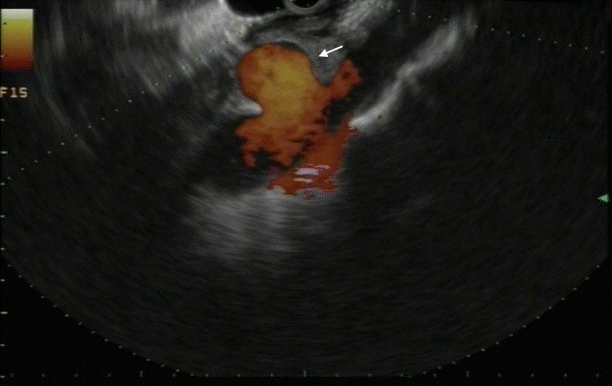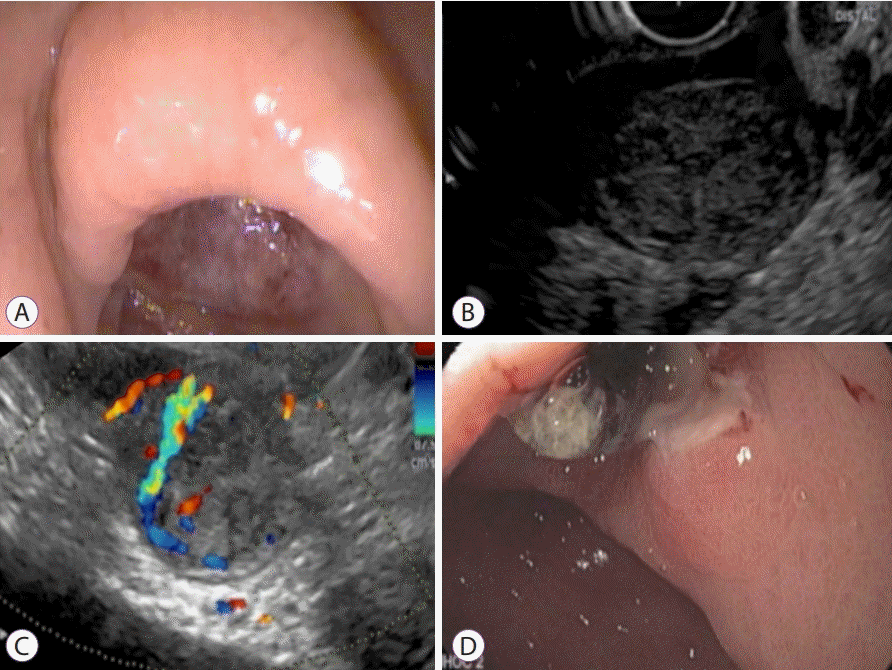1. Weilert F, Binmoeller KF. EUS-guided vascular access and therapy. Gastrointest Endosc Clin N Am. 2012; 22:303–314, x.

2. Saxena P, Lakhtakia S. Endoscopic ultrasound guided vascular access and therapy (with videos). Endosc Ultrasound. 2015; 4:168–175.

3. Abraldes JG, Bosch J. The treatment of acute variceal bleeding. J Clin Gastroenterol. 2007; 41(Suppl 3):S312–S317.

4. Helmy A, Hayes PC. Review article: current endoscopic therapeutic options in the management of variceal bleeding. Aliment Pharmacol Ther. 2001; 15:575–594.
5. Irisawa A, Obara K, Bhutani MS, et al. Role of para-esophageal collateral veins in patients with portal hypertension based on the results of endoscopic ultrasonography and liver scintigraphy analysis. J Gastroenterol Hepatol. 2003; 18:309–314.

6. Hou MC, Lin HC, Lee FY, Chang FY, Lee SD. Recurrence of esophageal varices following endoscopic treatment and its impact on rebleeding: comparison of sclerotherapy and ligation. J Hepatol. 2000; 32:202–208.

7. Lahoti S, Catalano MF, Alcocer E, Hogan WJ, Geenen JE. Obliteration of esophageal varices using EUS-guided sclerotherapy with color Doppler. Gastrointest Endosc. 2000; 51:331–333.

8. Weilert F, Binmoeller KF. New endoscopic technologies and procedural advances for endoscopic hemostasis. Clin Gastroenterol Hepatol. 2016; 14:1234–1244.

9. Goral V, Yılmaz N. Current approaches to the treatment of gastric varices: glue, coil application, TIPS, and BRTO. Medicina (Kaunas). 2019; 55:335.

10. Seewald S, Ang TL, Imazu H, et al. A standardized injection technique and regimen ensures success and safety of N-butyl-2-cyanoacrylate injection for the treatment of gastric fundal varices (with videos). Gastrointest Endosc. 2008; 68:447–454.

11. Romero-Castro R, Pellicer-Bautista FJ, Jimenez-Saenz M, et al. EUS-guided injection of cyanoacrylate in perforating feeding veins in gastric varices: results in 5 cases. Gastrointest Endosc. 2007; 66:402–407.

12. Romero-Castro R, Ellrichmann M, Ortiz-Moyano C, et al. EUS-guided coil versus cyanoacrylate therapy for the treatment of gastric varices: a multicenter study (with videos). Gastrointest Endosc. 2013; 78:711–721.

13. Wang X, Yu S, Chen X, Duan L. Endoscopic ultrasound-guided injection of coils and cyanoacrylate glue for the treatment of gastric fundal varices with abnormal shunts: a series of case reports. J Int Med Res. 2019; 47:1802–1809.

14. Bhat YM, Weilert F, Fredrick RT, et al. EUS-guided treatment of gastric fundal varices with combined injection of coils and cyanoacrylate glue: a large U.S. experience over 6 years (with video). Gastrointest Endosc. 2016; 83:1164–1172.

15. Hosking SW, Smart HL, Johnson AG, Triger DR. Anorectal varices, haemorrhoids, and portal hypertension. Lancet. 1989; 1:349–352.

16. Chawla Y, Dilawari JB. Anorectal varices--their frequency in cirrhotic and non-cirrhotic portal hypertension. Gut. 1991; 32:309–311.

17. Boregowda U, Umapathy C, Halim N, et al. Update on the management of gastrointestinal varices. World J Gastrointest Pharmacol Ther. 2019; 10:1–21.

18. Sato T, Yamazaki K, Akaike J, Toyota J, Karino Y, Ohmura T. Retrospective analysis of endoscopic injection sclerotherapy for rectal varices compared with band ligation. Clin Exp Gastroenterol. 2010; 3:159–163.
19. Sharma M, Somasundaram A. Massive lower GI bleed from an endoscopically inevident rectal varices: diagnosis and management by EUS (with videos). Gastrointest Endosc. 2010; 72:1106–1108.
20. Mukkada RJ, Mathew PG, Francis Jose V, Paul Chettupuzha A, Antony R, Koshy A. EUS-guided coiling of rectal varices. VideoGIE. 2017; 2:208–210.

21. Weilert F, Shah JN, Marson FP, Binmoeller KF. EUS-guided coil and glue for bleeding rectal varix. Gastrointest Endosc. 2012; 76:915–916.

22. Levy MJ, Wong Kee Song LM, Farnell MB, Misra S, Sarr MG, Gostout CJ. Endoscopic ultrasound (EUS)-guided angiotherapy of refractory gastrointestinal bleeding. Am J Gastroenterol. 2008; 103:352–359.
23. Law R, Fujii-Lau L, Wong Kee Song LM, et al. Efficacy of endoscopic ultrasound-guided hemostatic interventions for resistant nonvariceal bleeding. Clin Gastroenterol Hepatol. 2015; 13:808–812.e1.

24. Naseer M, Lambert K, Hamed A, Ali E. Endoscopic advances in the management of non-variceal upper gastrointestinal bleeding: a review. World J Gastrointest Endosc. 2020; 12:1–16.

25. Bosch J, Abraldes JG, Berzigotti A, García-Pagan JC. The clinical use of HVPG measurements in chronic liver disease. Nat Rev Gastroenterol Hepatol. 2009; 6:573–582.

26. Sarin SK, Khanna R. Non-cirrhotic portal hypertension. Clin Liver Dis. 2014; 18:451–476.

27. Lai L, Poneros J, Santilli J, Brugge W. EUS-guided portal vein catheterization and pressure measurement in an animal model: a pilot study of feasibility. Gastrointest Endosc. 2004; 59:280–283.

28. Brugge WR. EUS is an important new tool for accessing the portal vein. Gastrointest Endosc. 2008; 67:343–344.

29. Giday SA, Clarke JO, Buscaglia JM, et al. EUS-guided portal vein catheterization: a promising novel approach for portal angiography and portal vein pressure measurements. Gastrointest Endosc. 2008; 67:338–342.

30. Magno P, Ko CW, Buscaglia JM, et al. EUS-guided angiography: a novel approach to diagnostic and therapeutic interventions in the vascular system. Gastrointest Endosc. 2007; 66:587–591.

31. Huang JY, Samarasena JB, Tsujino T, et al. EUS-guided portal pressure gradient measurement with a simple novel device: a human pilot study. Gastrointest Endosc. 2017; 85:996–1001.

32. Buscaglia JM, Dray X, Shin EJ, et al. A new alternative for a transjugular intrahepatic portosystemic shunt: EUS-guided creation of an intrahepatic portosystemic shunt (with video). Gastrointest Endosc. 2009; 69:941–947.

33. Schulman AR, Popov V, Thompson CC. Randomized sham-controlled trials in endoscopy: a systematic review and meta-analysis of adverse events. Gastrointest Endosc. 2017; 86:972–985.e3.

34. Bosch J. EUS-guided intrahepatic portosystemic shunt: a real alternative to transjugular intrahepatic portalsystemic shunt? Gastrointest Endosc. 2017; 85:248–249.

35. Pommergaard HC, Rostved AA, Adam R, et al. Vascular invasion and survival after liver transplantation for hepatocellular carcinoma: a study from the European Liver Transplant Registry. HPB (Oxford). 2018; 20:768–775.

36. Michael H, Lenza C, Gupta M, Katz DS. Endoscopic ultrasound -guided fine-needle aspiration of a portal vein thrombus to aid in the diagnosis and staging of hepatocellular carcinoma. Gastroenterol Hepatol (N Y). 2011; 7:124–129.
37. Kayar Y, Turkdogan KA, Baysal B, Unver N, Danalioglu A, Senturk H. EUS-guided FNA of a portal vein thrombus in hepatocellular carcinoma. Pan Afr Med J. 2015; 21:86.

38. Ting DT, Wittner BS, Ligorio M, et al. Single-cell RNA sequencing identifies extracellular matrix gene expression by pancreatic circulating tumor cells. Cell Rep. 2014; 8:1905–1918.

39. Chapman CG, Waxman I. EUS-guided portal venous sampling of circulating tumor cells. Curr Gastroenterol Rep. 2019; 21:68.

40. Faigel DO, Kachaamy T, Lake D, et al. Safety and toxicity of EUS-guided portal injection chemotherapy (EPIC) using drug-eluting microbeads. Gastrointest Endosc. 2016; 83(5 Suppl):AB150.
41. Fritscher-Ravens A, Ganbari A, Mosse CA, Swain P, Koehler P, Patel K. Transesophageal endoscopic ultrasound-guided access to the heart. Endoscopy. 2007; 39:385–389.

42. Somani P, Sharma M, Patil A, Kumar A. Endoscopic ultrasound-guided fine needle aspiration of a pericardial mass. Endoscopy. 2016; 48(Suppl 1):E45–E46.

43. Romero-Castro R, Rios-Martin JJ, Gallego-Garcia de Vinuesa P, et al. Pericardial tumor diagnosed by EUS-guided FNA (with video). Gastrointest Endosc. 2009; 69(3 Pt 1):562–563.

44. Gornals JB, de la Hera M, de Albert M, Claver E, Catala I. EUS cardiac puncture-guided right atrial tumor. Gastrointest Endosc. 2015; 82:165.







 PDF
PDF Citation
Citation Print
Print




 XML Download
XML Download